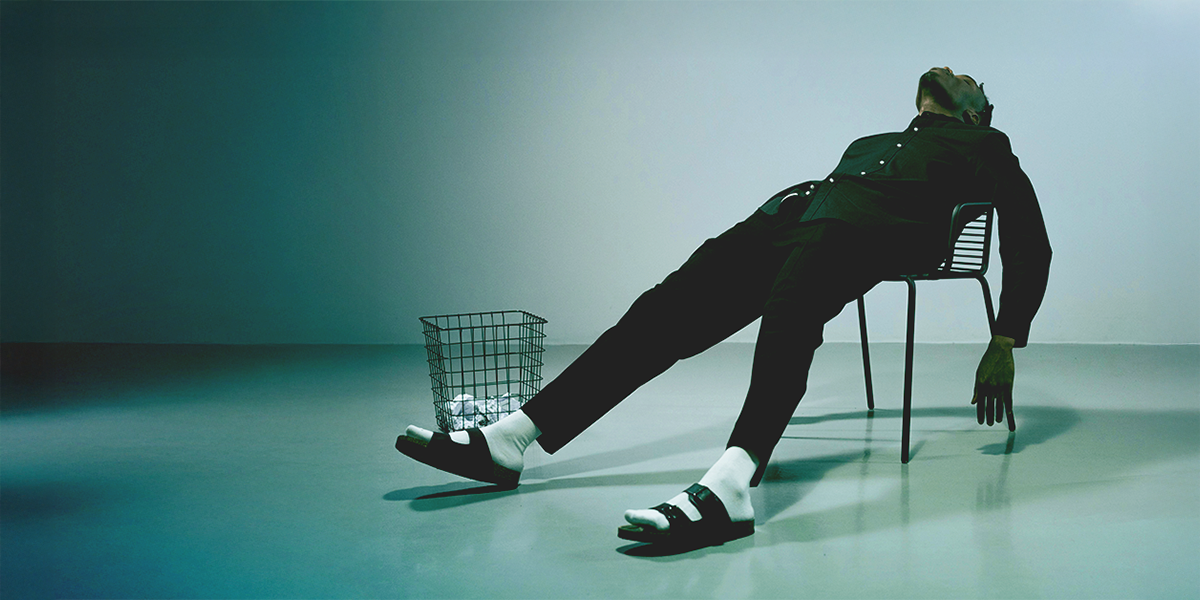
It was 8:20 AM on a Saturday when I opened up my wardrobe.
I had to go to the gym for a group training session with some teammates. But truth be told, I didn’t want to go.
It had been a big week.
I was tired.
My bedroom was warm and toasty, and it was freezing outside.
“Would they even miss me if I didn’t go? Everyone skips a session now and then, don’t they?”
All of these thoughts ran through my head as I put on my clothes, went outside, and waited for the car to warm up. Then I pressed play on my “Get pumped” playlist, and a switch flipped in my head.
I was ready.
I’ve done this before.
I can do this.
That right there? ☝️ That’s the power of anchoring.
Here’s the thing: Everyone has anchors. Seemingly insignificant aspects of daily life trigger an emotion, whether it’s a certain song that suddenly takes you back to high school or that jacket that makes you feel like you can do anything.
And yet, few of us actually stop to think about what our anchors are.
What’s more, when you use anchors deliberately, they can become a valuable tool to help you build habits, perform better, and reach your goals.
I first discovered anchoring when I was fresh out of college, and I’m not kidding: It. Changed. My. Life. And if you can master this simple concept, I promise you that it will change yours, too—in some way, shape, or form.
What you need to know about anchoring and associative learning
Anchoring happens when an action or event acts as a stimulus to generate a response. It’s a form of associative learning, where your brain creates powerful connections between different experiences, feelings, or behaviors.
You’ve probably heard about Pavlov’s Dogs—it’s the classic example of how our brains learn through association. This scientist named Pavlov would ring a bell every time he fed his dogs. Through this associative learning process, the dogs’ brains started connecting the sound of the bell with food. Eventually, they’d start drooling just from hearing the bell, even when there wasn’t any food around.
Maybe you don’t start drooling at the sound of a bell, but you have likely experienced something similar. Your phone may be the best example: That specific notification sound from your favorite dating app probably gets your heart racing before you even check the message. Or maybe that one song from your study playlist instantly puts you in focus mode, even when you’re not studying.
Jim from The Office actually used this same principle to mess with Dwight, conditioning him to want an Altoid every time his computer rebooted:
We all have anchors, positive and negative. You might smell fresh-cooked pasta and instantly feel a sense of calm because it takes you back to your childhood. Or you might get anxious every time you hear the phone ring because it reminds you of an unpleasant call that you had at an earlier point in your life.
But when you proactively start to use anchors, they get really, really powerful.
Think about Tiger Woods with his iconic red polo shirt during golf tournaments. Or Rafael Nadal’s pre-serve ritual that he did 146 times in his match against Denis Shapovalov:
Both of these athletes have an anchor that helps them get into the right frame of mind for success.
And with a little help, you can too.
The benefits of anchoring
One of the reasons I love anchoring so much is because it’s beneficial in so many scenarios.
It’s a good method to stay consistent when you’re trying to build habits because let’s face it: it’s nearly impossible to succeed on pure willpower alone.
It doesn’t matter who you are or what you do. At some point, your motivation tank will run dry, and you’ll need a little top-up to keep you going. With an anchor, you have something to come back to over and over again, using it to form habits and shift your mindset.
I’ve seen this a lot with people when they had to work from home during the pandemic.
When you’re going at it alone without a commute to the office or colleagues to keep you accountable, it’s easy to descend into playing video games instead of ACTUALLY doing work.
To counteract this natural desire to procrastinate, one of my friends started using clothing as an anchor to put herself into “work” mode every day.
Even though she wasn’t going to the office, she’d get ready in the morning just like she was. This helped her stick to her routine and be productive while working from home.
Her situation hadn’t changed, but her mindset had.
Because her brain already had associations of certain outfits with work, it made it a lot easier for her to switch to thinking about business, even though she wasn’t in a business environment.
Anchoring is also an incredibly useful tool for shifting your mood, especially if you’re dealing with negative emotions.
You know that feeling you get when you feel anxious? The whole world feels like it’s imploding, and you feel powerless to stop it—like you’re in the middle of the ocean on a stormy night.
In this instance, anchoring literally acts as a mental anchor to keep your emotions stable and in check.
When I feel the anxiety bubbling up, I like to use sandalwood incense. Every time I smell it, I’m immediately transported back to Kyoto, traversing through temples in the fall, without a care in the world. Before I know it, I’m calm, my heart rate has slowed, and the anxiety has subsided—all because of that one familiar smell.
Breaking down the five different types of anchors
In case you haven’t gathered already, anchors can literally be anything. They can be a certain outfit, a song, or even a mantra that you repeat to yourself.
Different anchors work for different people, depending on which senses evoke the strongest response in you or what’s most suitable for your individual situation.
For example, it wouldn’t make sense to use an incense smell as an anchor for work-related stresses (unless you’re a baller and you have your own office). You want something accessible to you at all times, and that isn’t too conspicuous, like a picture on your desk or a song you can play on your phone.
If you want to get the most out of anchoring, you need to start at the basics: understanding what types of anchors to use and when.
Visual anchors
Visual anchors use sight to trigger a certain mental state. These can either be external objects or images that you look at, like a photo, an object, or an outfit. Or, an internal anchor that you visualize in your mind, such as a place you used to visit as a child.
Internal anchors are more common because of how readily accessible they are. However, while you don’t need to have an overactive imagination, these anchors do need to feel as real as possible, because you want your brain to fully connect and experience the emotions that you would if you were there in real life.
I picked up a great external visual anchor when I was at a Yoko Ono exhibit years and years ago. There was a jar filled with puzzle pieces from a jigsaw of the sky—the idea being that everyone who took one would be connected through these individual pieces. I carry that puzzle piece in my wallet, and every time I feel alone, I look at it, and it gives me that sense of connectedness that I felt at the exhibition.
Olfactory anchors
The olfactory system refers to the structures that give us our sense of smell. And given that smell is the strongest human sense, it’s no surprise that scents are really effective at anchoring us to a certain mood or feeling.
In fact, it’s so effective that the legendary Wolf of Wall Street himself, Jordan Belfort, used olfactory anchoring to manage his mental state.
When he closed a deal and was feeling on top of the world, Belfort would sniff a scented nasal inhaler. Then the next time before a big meeting, he’d use the same nasal inhaler to bring his mindset back to that state of confidence.
Kinesthetic anchors
Kinesthetic anchors use touch or movement to evoke a specific mental state. These might be anything from making a fist with your hand, to touching your wrist, to putting your hands on your thighs, or striking a power pose in the bathroom.
Kinesthetic anchors are among the easiest to implement because you can do them anywhere at any time. You can also combine touch or movement with another anchor, like Tony Robbins’ infamous “swish change”:
Auditory anchors
One of my favorites, the auditory anchor, uses sound to pull us back to a certain state of mind. Mantras are probably the most common amongst auditory anchors, whether it’s chanted internally or exclaimed loudly like Frank Costanza:
Other auditory anchors could involve making a noise, like whistling or listening to a song or poem on your phone.
Gustatory anchors
As you’ve probably guessed, gustatory anchors involve the fifth sense: taste. This one is the least accessible of the five, but it’s still possible to use taste to put yourself in a specific mental state.
I know multiple people who like to chew gum before working out. Even though they clearly don’t need to freshen their breath to train, the act of chewing the gum is like starting the engine in the car: once they pop a piece into their mouth, they’re ready to get moving.
How to use anchors and associative learning in your daily life
Creating your own anchors isn’t rocket science—it just takes some intentional practice and consistency. Think of it like training a puppy: at first, it seems impossible, but with enough repetition and the right approach, suddenly everything clicks.
Here’s how to get started:
1. Choose your target state of mind
First, get crystal clear about what mental state you’re trying to achieve. Maybe you want to feel confident before big presentations, or focused when you sit down to study, or calm when you’re dealing with stress. The more specific you can be, the better.
2. Pick your anchor carefully
This is where most people mess up—they choose anchors that aren’t practical in real life. Sure, burning sage might help you relax, but good luck doing that in the middle of a work meeting. Pick something subtle and accessible:
- A specific playlist or song
- A small object you can keep in your pocket (like a worry stone)
- A quick physical movement
- A specific phrase or mantra (like “progress not perfection”)
- Even just a deliberate deep breath
3. Build the association
Next, you need to create that connection between your anchor and your desired state of mind. Here’s what I mean:
- Start by identifying moments when you naturally feel the way you want to feel (elation after a good gym session or waking up rested after a full night’s sleep, for example)
- Immediately use your chosen anchor in those moments
- Really lean into the feeling while you’re using your anchor
- Practice this at least 5-6 times before trying to use it in a high-pressure situation
4. Test and adjust
Your first anchor might not stick—and that’s totally fine. If something isn’t working after a few weeks, try a different approach. The key is to keep experimenting until you find what clicks for you.
It’s hard to understate the role that mindfulness plays when it comes to associative learning. If that’s a topic you want to explore more, we have some great resources here:
Examples of anchoring psychology in action
To help you get a better idea of what psychological anchoring looks like in practice, let’s look at a few examples of how you might use it for important moments in life.
Preparing for a new job
You’re starting a new job this week, and you’re feeling anxious about what your first day might be like. You know you’ll be meeting lots of new people and learning about all of the new tasks and responsibilities you have.
In the days leading up to your start date, you use psychological anchoring to prepare yourself for these new challenges. You keep a half-dollar in your pocket, and any time you’re with friends and enjoying the feeling of being with them, you reach into your pocket and discreetly flip it over and over between your fingers.
You also sit down to watch a few YouTube videos about topics you aren’t familiar with, and you practice this same coin-flipping action every time you feel one of the new lessons click.
You keep that half-dollar in your pocket on your first day of work. When you feel anxiety creeping in when meeting new people or learning a complicated new task, you reach in your pocket and flip the coin a few times. Your brain recognizes the action from your pleasant social/learning situations from the days prior, and allows you to relax and re-focus on what’s happening at your new job.
Studying for a big exam
You’re staring at a mountain of material the night before a huge test, wondering how we’re going to get through it all. But with psychological anchoring, you can actually train your brain to slip into study mode faster and retain information better.
Let’s say you’ve got a major final coming up in three weeks. You decide to create two different anchors: one for focused studying, and one for confident test-taking.
For your study anchor, you pick a specific essential oil (let’s say rosemary) and a pair of noise-canceling headphones. Every time you sit down to study and feel yourself getting into a good flow state, you put a drop of oil on your wrist and put on the headphones, even if you’re not playing any music.
After a few study sessions, just the smell of rosemary and the gentle pressure of the headphones tells your brain, “Okay, it’s time to focus.” You’ve created a psychological environment that helps you concentrate, even if you’re studying in a noisy café or your chaotic dorm room.
Then, for test-taking confidence, you choose a power pose (think Superman stance) that you can do quickly in the bathroom before the exam. In the weeks leading up to the test, you practice this pose every time you successfully remember something you’ve studied or solve a particularly tough practice problem.
By the time test day rolls around, a quick trip to the bathroom for your power pose helps activate those feelings of competence and knowledge, rather than letting test anxiety take over.
Navigating networking events
A career fair or industry meetup can be overwhelming. The room buzzes with conversation, and your confidence wavers. This is where psychological anchoring becomes valuable.
Create a simple anchor using your watch or bracelet a week before the event. When you’re having great conversations with friends or classmates and feeling socially confident, adjust your watch on your wrist three times.
Practice this anchor while watching videos of successful networkers or reading about interesting topics in your industry. Any time you discover something worth discussing, do the watch adjustment.
At the networking event, your anchor is ready. Adjust your watch three times before approaching that group from your dream company. Your brain connects to those feelings of social confidence and intellectual curiosity you’ve been building.
You’ll find yourself naturally remembering those interesting industry topics you’ve been reading about. When someone asks about your background, you’ll feel as comfortable as you do telling stories to your friends, all because you’ve trained your brain to associate that simple watch adjustment with positive social interactions.
The gesture is subtle. Other attendees just see someone who seems naturally confident and engaging in conversation.
By the way, if you need some networking advice to start with, check out these articles:
Common pitfalls when using psychological anchors
Psychological anchoring isn’t a skill you can pick up overnight. (It took Pavlov weeks to get those dogs to start drooling!) But you can certainly speed up the process by avoiding these common mistakes people make when practicing associative learning.
Choosing complicated anchors
Your anchor needs to be something you can do anywhere, anytime. A complex breathing pattern or an elaborate hand gesture won’t work when you’re in the middle of a job interview. Keep it simple—adjusting a ring, touching your collar, or taking a single deep breath are often all you need.
Using the same anchor for everything
Your brain needs clear, specific associations. Using the same anchor for confidence, focus, and relaxation just creates confusion. Choose different anchors for different mental states and keep them separate.
Not practicing enough
Psychological anchoring isn’t a quick fix. You need to practice your anchor at least five to ten times in genuinely positive situations before trying to use it when you’re stressed or nervous. Many people try to use an anchor in an important moment without building up the association first, and then assume it isn’t working at all.
Choosing anchors that rely on other people
Anchors that depend on external validation don’t work well. If you’re using a friend’s encouraging words or social media likes as your anchor, you won’t be able to access that feeling when you’re alone or offline. Choose anchors you can control.
Getting discouraged too quickly
Your first attempt at anchoring might not stick. That’s normal. If an anchor isn’t working after a few weeks of consistent practice, try a different one. The process of finding the right anchor is personal—what works for someone else might not work for you.
Set yourself up for success with anchoring
Just remember that anchoring works differently for everyone.
The most effective and accessible anchors for me may not be the same for the person next to me, so it’s a good idea to experiment and see what resonates with you.
The last thing I’ll say is this: Anchors have been incredibly helpful to me over the years. They’ve helped me keep calm in tough times, build habits when I didn’t have the motivation, and achieve my goals.
And if you use them wisely, I know they’ll help you too.

















